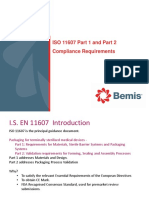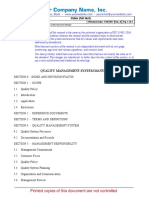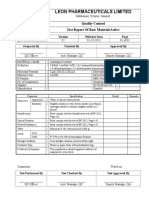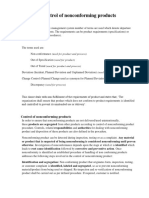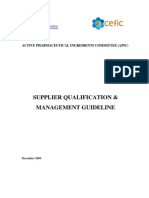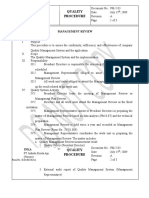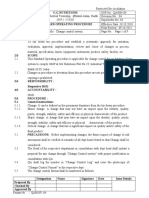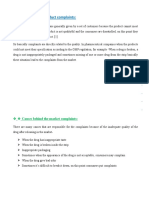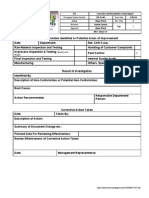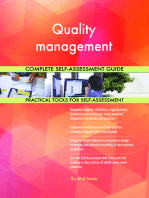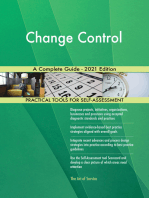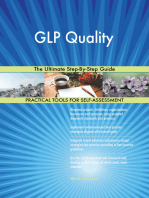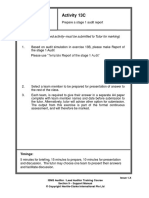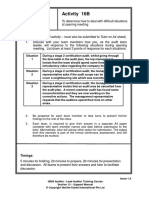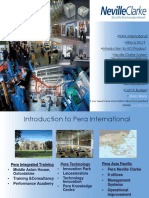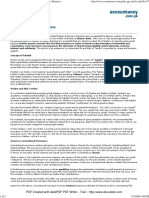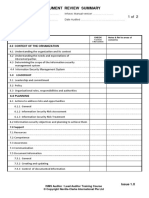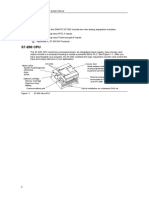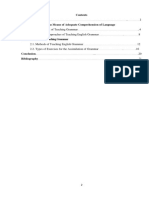Supplier Quality Standard PDF
Supplier Quality Standard PDF
Uploaded by
drmohamed120Copyright:
Available Formats
Supplier Quality Standard PDF
Supplier Quality Standard PDF
Uploaded by
drmohamed120Original Title
Copyright
Available Formats
Share this document
Did you find this document useful?
Is this content inappropriate?
Copyright:
Available Formats
Supplier Quality Standard PDF
Supplier Quality Standard PDF
Uploaded by
drmohamed120Copyright:
Available Formats
Baxter International Inc.
One Baxter Parkway
Deerfield, IL 60015
(224) 948-2000
Supplier Quality Standard
1.0 Purpose
The purpose of this Supplier Quality Standard is to communicate the expectations and requirements
of Baxter Healthcare Corporation to its suppliers.
These expectations are based on Baxter’s philosophy of defect prevention and continuous
improvement by developing quality into products and services rather than defect detection after they
are produced.
The requirements within this standard are provided as a supplement to, and do not replace or alter
the terms or conditions within Baxter’s Purchase Orders, Quality Agreements, engineering drawings
and/or specifications and/or any agreement between Baxter and the supplier.
In this standard, sentences containing shall are requirements, sentences in italics or containing
should are provided for guidance only.
2.0 Applicability
This standard, identified in the Quality Agreement, applies to Baxter suppliers who provide:
• Parts
• Materials
• Assemblies
• Printed Material
• Services, which can impact product quality
• Finished goods, both those that carry the Baxter trademark, as well as distributed product.
• Contract Design and Development
• Custom application or embedded software
3.0 Associated Documents
3.1 Reference
ISO 9001 Quality Management Systems – Requirements
ISO/TR 10017 Guidance on Statistical Techniques for ISO 9001
ISO 13485 Medical Devices – Quality Management Systems – Requirements for
Regulatory Purposes 2nd Edition
ISO14001 Environmental Management Standard
This document is for informational purposes only. Should you need further information, please contact your Purchasing representative.
ISSUE DATE: 09-JUL-2014
EFFECTIVE DATE: 07-SEP-2014
Baxter International Inc.
One Baxter Parkway
Deerfield, IL 60015
(224) 948-2000
ISO14971 Medical Devices – Application of risk management to medical devices
ICH Q7A Good Manufacturing Practice Guide for Active Pharmaceutical
Ingredients
ICH8 Pharmaceutical Development
ICH9 Quality Risk Management
ICH10 Pharmaceutical Quality Systems Handbook
EudraLex – Volume 1 Pharmaceutical Legislation Medicinal Products for Human Use
EudraLex – Volume 2 Pharmaceutical Legislation Notice to applicants and regulatory
guidelines medicinal products for human use
EudraLex – Volume 4 Good Manufacturing Practice (GMP) Guidelines
EUCD 93/42 European Union Commission Directive – Medical Device Directive
(MDD)
FDA 21 CFR §820 Title 21 Food and Drugs, Subchapter H Medical Devices,
Parts 820 Quality System Regulation
FDA 21 CFR §210 & 211 Title 21 Food and Drugs, Subchapter H Medical Devices,
Parts 210 & 211 cGMP in Manufacturing, Processing, Packaging, or
Holding of Drugs and Finished Pharmaceuticals
FDA 21 CFR § 606 Title 21 Food and Drugs, cGMP for Blood and Blood Components
FDA 21 CFR § 610 Title 21 Food and Drugs, General Biological Product Standards
Health Canada Canadian Medical Device Regulations
Health Canada Canada Good Manufacturing Practices (GMP) Guidelines
IPEC–PQC GMP The Joint IPEC-PQC Good Manufacturing Practices Guide for
Pharmaceutical Excipients
MHLW Japanese Pharmaceutical Affairs Law
MHLW No. 179 Japan - Ministerial Ordinance on Standards for Manufacturing Control
and Quality Control for Drugs and Quasi-drugs
MHLW No. 169 Japan – Ministerial Ordinance on Standards for Manufacturing Control
and Quality Control for Medical Devices and In-vitro Diagnostic
Reagents
This document is for informational purposes only. Should you need further information, please contact your Purchasing representative.
ISSUE DATE: 09-JUL-2014
EFFECTIVE DATE: 07-SEP-2014
Baxter International Inc.
One Baxter Parkway
Deerfield, IL 60015
(224) 948-2000
4.0 Definitions
Definitions are available in Appendix I (Section 13) of this standard.
5.0 Responsibility and Authority
It is the responsibility of the supplier to understand and ensure compliance with this standard and
Baxter’s engineering requirements, specifications and drawings.
Supplier Quality personnel within Baxter are responsible for maintaining this standard and
establishing, maintaining and evaluating approved suppliers.
6.0 Introduction
This standard emphasizes:
• The importance of establishing defined and mutually agreed upon requirements.
• The expectation that suppliers develop and maintain a comprehensive quality system that
ensures Baxter receives product and services that conform to requirements.
• A continual focus on improvement in quality, cost, and innovation, including sustainability, to
mutually benefit the supplier and Baxter.
• Manufacturing in accordance with appropriate current Good Manufacturing Practices
(cGMP).
6.1 Supplier Expectations
Baxter’s suppliers shall develop and maintain a management system to assure consistent
conformance of their products and services to specified requirements.
Note: A quality system that demonstrates conformity to ISO 9001 establishes a base from which a
supplier can focus on quality and continually strive to improve. Although not required by
Baxter, suppliers are encouraged to have their conformance confirmed by an independent
audit (such as 3rd party certification).
Suppliers shall fully comply with the Baxter Ethics and Compliance Standards for Suppliers/ Code of
Conduct discussed later in this manual.
6.2 Suppliers are fully responsible for the quality of their products.
Suppliers shall ensure that each of their products or services comply with all the requirements
mutually agreed to with Baxter as well as all applicable requirements defined by regulatory agencies
(such as FDA and Health Canada). Suppliers are accountable for and assume full responsibility for
the quality of the products or services they provide. Approval and verification, by Baxter, of
supplier’s facilities, systems, and records does not absolve the supplier of the responsibility to
provide acceptable product.
This document is for informational purposes only. Should you need further information, please contact your Purchasing representative.
ISSUE DATE: 09-JUL-2014
EFFECTIVE DATE: 07-SEP-2014
Baxter International Inc.
One Baxter Parkway
Deerfield, IL 60015
(224) 948-2000
6.3 Suppliers are fully responsible for their supply chain.
Baxter’s suppliers are responsible for the quality and material compliance related activities of their
suppliers, subcontractors, service providers, and/or material sources. Suppliers shall document and
verify that their suppliers’ facilities, procedures, materials, and controls meet or exceed the agreed to
requirements. Baxter should request supporting data of these evaluations. Baxter shall rely on its
supplier’s to maintain control of their supply base, but reserves the right to audit or evaluate these
sources to ensure supply chain safety and/or understand other potential impacts to Baxter.
7.0 Quality System Requirements
Baxter’s suppliers shall have a defined quality system. This section specifies the requirements of a
comprehensive quality system that is important to ensure Baxter receives products and services that
conform to requirements.
7.1 Quality Manual, Policy and Objectives
The supplier shall document its quality system. This should include a stated quality policy and
quality manual.
Note: A quality manual defines the structure of their quality system, by defining the scope of the
quality system, by describing how processes of the quality system interact and by
referencing documented procedures used to implement the quality system.
The quality policy defines a supplier’s intent and direction with respect to Quality and serves
as a general framework for action.
Measurable quality objectives shall be established. The supplier’s quality objectives shall be
measurable and consistent with the quality policy. Once quality objectives are established for
relevant functions and levels of the supplier’s organization they shall be monitored by the supplier to
ensure an effective quality system and customer focus.
The supplier shall identify its necessary procedures and records that ensure effective operation and
control of its processes.
7.2 Control of Documents
The supplier shall identify essential documents relating or pertinent to the quality system and control
such documents. The supplier’s document control methods shall ensure that only approved, issued,
and effective documents are utilized.
Documents shall be legible and identifiable. With respect to documents which become obsolete but
are retained, the supplier shall have a method of identification of such documents as obsolete and
segregation of such documents to prevent accidental use.
This document is for informational purposes only. Should you need further information, please contact your Purchasing representative.
ISSUE DATE: 09-JUL-2014
EFFECTIVE DATE: 07-SEP-2014
Baxter International Inc.
One Baxter Parkway
Deerfield, IL 60015
(224) 948-2000
7.3 Control of Records
The supplier shall maintain legible, readily identifiable and retrievable records as evidence its
products meet Baxter’s requirements. Examples of records a supplier should retain, to demonstrate
its conformance to requirements, include test results, equipment verification records and calibration
records.
The supplier shall define how it identifies, stores, protects, retains and disposes of its records.
Note: A supplier should determine its record retention period to be equivalent to the lifetime of the
product, as defined by the supplier unless Baxter defines the record retention duration per
the Quality Agreement.
Note: The supplier should use Good Documentation Practices (GDP) when creating and
maintaining records to ensure clear, complete and accurate information is recorded. Baxter
recommends that the supplier have rules that describe GDP when approving, making
handwritten entries on, copying, and/or modifying documents. Some GDP examples are
avoiding the use of white out to make corrections, avoiding the use of pencil, ensuring
records are dated correctly at the time created, recording the appropriate approvals, and
ensuring personnel don’t review and approve their own work.
7.4 Management Responsibility
The supplier shall ensure that responsibilities and authorities are defined, documented, and
communicated within its organization. The supplier shall maintain the appropriate resources for an
effective quality system.
7.5 Management Review
The supplier shall regularly review its quality system to ensure the ongoing suitability, adequacy and
effectiveness of the quality system.
Note: A review of the quality system should include written documentation of audit results,
customer feedback, process monitoring results, and product performance. After the review
opportunities for improvement should be considered.
The supplier shall maintain records of its decisions or actions from the review in accordance with
Section 7.3.
7.6 Design and Development Control
The supplier shall use specified requirements, specifications and drawings as the basis for its design
and development plan.
Note: The plan, sometimes called a quality plan, defines the design stages with necessary steps
and resources to assure the product satisfies Baxter’s requirements. The plan should be
maintained throughout the design process and should incorporate design reviews,
verification and validation plans, monitoring activities, inspection criteria or test requirements.
This document is for informational purposes only. Should you need further information, please contact your Purchasing representative.
ISSUE DATE: 09-JUL-2014
EFFECTIVE DATE: 07-SEP-2014
Baxter International Inc.
One Baxter Parkway
Deerfield, IL 60015
(224) 948-2000
The supplier’s design verification shall be planned and recorded to confirm the supplier’s design
meets requirements.
The supplier’s design validation activities shall be planned and recorded to confirm the product
meets the user requirements and is fit for use.
The supplier shall use its design outputs to establish a controlled operation at its manufacturing, test
or inspection location.
Note: Design outputs are engineering drawings and specifications of the design, critical process
parameters (CPP), critical to quality (CTQ), essential requirements checklist (ERC), or
essential to design outputs (EDO), and product acceptance criteria.
Baxter’s suppliers shall implement a change process that ensures any effects on the product are
understood. The supplier’s change process shall include necessary reviews, verification of change
and validation of the product before the change is implemented in accordance with Section 9.0.
7.7 Purchasing Controls
Baxter’s suppliers shall define requirements and establish a supplier selection process that ensures
that their suppliers have the potential and ability to meet specified requirements.
The supplier is responsible for the quality of all components and raw materials it purchases for its
product. Where components and raw materials do not meet specified requirements then the
supplier shall document its mitigation activity. If necessary, the supplier is responsible for additional
controls to ensure its product satisfies requirements.
When the supplier implements inspection or other activities to ensure that purchased product meets
requirements then these methods and results shall be documented. Records shall be maintained in
accordance with Section 7.3 and made available to Baxter upon request.
7.8 Production Provisions
The supplier shall document and control its production conditions to ensure its product meets
specified requirements.
Note: This may require the supplier to make use of documented procedures, work instructions,
reference materials, suitable equipment and specific monitoring and measurement devices
where the absence of such could affect quality.
The supplier’s controls shall be established using the appropriate design outputs and available at the
manufacturing, test, or inspection location.
Note: This should include current engineering drawings and specifications, critical process
parameters (CPP), critical to quality (CTQ), essential requirements checklist (ERC), or
essential to design outputs (EDO), and product acceptance criteria.
The supplier shall protect product, equipment, and personnel against potential contamination.
This document is for informational purposes only. Should you need further information, please contact your Purchasing representative.
ISSUE DATE: 09-JUL-2014
EFFECTIVE DATE: 07-SEP-2014
Baxter International Inc.
One Baxter Parkway
Deerfield, IL 60015
(224) 948-2000
Note: The supplier should document cleanliness requirements, monitor conditions or make special
arrangements to protect product quality and health of personnel.
When a sterilization process is necessary, the supplier shall record its process parameters and
maintain traceability for each production batch.
Baxter’s suppliers shall employ process controls, which are consistent and appropriate for the
operations being conducted. Where the operation may result in product not meeting specifications
Baxter’s suppliers shall implement documented mitigation activities, such as enhanced control plan,
verification and inspection, or process control parameters.
Note: Process control is a system for ensuring that product consistently falls within predefined
process parameters (limits).
Equipment, monitoring and measuring, labeling, packaging, cleanliness, and release activities shall
ensure the product meets Baxter’s requirements. Records shall be maintained in accordance with
Section 7.3 and made available to Baxter upon request.
7.9 Monitoring and Measuring of Process and Product
The supplier shall use appropriate measurement methods to monitor planned results of processes to
confirm its product meets specified requirements. Defining test methods in an established control
plan or similar document should ensure testing is conducted in accordance with the established limits
and frequency.
Baxter’s suppliers shall monitor critical to quality (CTQ), essential requirements checklist (ERC), or
essential to design output (EDO) product characteristics at appropriate stages of the production
process to confirm that product produced meets requirements. Records of these results shall be
used to authorize release of product to Baxter.
Note: Acceptance criteria for performance testing when planned and monitored are evidence the
product meets requirements.
Products not meeting specified requirements are cause for the supplier to investigate the process for
the cause, and take appropriate corrective action as necessary. Controls shall be in place to
prevent product delivery to Baxter until the conformity of the product is confirmed.
7.10 Validation of Processes for Production
Baxter’s suppliers shall qualify critical equipment and computerized systems before validation.
Note: This qualification should be carried out by conducting the appropriate design qualification
(DQ), installation qualification (IQ), operational qualification (OQ), performance qualification
(PQ) and/or process validation (PV).
When the output of a process is unable to be verified by testing, validation activities shall be
conducted by the supplier using a documented procedure. The qualified individual that conducts the
validation activity shall document its result and make the results available to Baxter upon request.
This document is for informational purposes only. Should you need further information, please contact your Purchasing representative.
ISSUE DATE: 09-JUL-2014
EFFECTIVE DATE: 07-SEP-2014
Baxter International Inc.
One Baxter Parkway
Deerfield, IL 60015
(224) 948-2000
The supplier’s validation shall confirm with objective evidence that the process consistently meets
the planned outcome. Therefore, the supplier shall validate products made from its production tools,
processes, and cycle times to confirm they meet the product requirements, specifications and
parameters.
The supplier shall periodically review and maintain process parameters established during
validation. These parameters are to be monitored and controlled to ensure product specifications
continue to be met.
Note: If trends outside predefined process parameter limits are found the trend should be
investigated, corrective action may be taken and revalidation considered.
Prior to implementing any modification to a process, the supplier shall complete necessary
verifications and tests (including preliminary capability studies) to ensure the process produces
product that meet specified requirements. The supplier shall implement changes in accordance with
Section 9.0 Supplier Notice of Change.
7.11 Product Identification and Traceability
The supplier shall establish a system for the control of all materials.
Note: Control procedures are to ensure that products are properly identified and do not become
mixed with other orders.
The supplier shall identify product status throughout the production process to ensure that only
product that has passed the required inspections and tests are shipped to Baxter.
The supplier shall establish a traceability system that tracks components from raw material through
inspection, test, and final release operations, including rework and sub-supplier procedures.
7.12 Control of Inspection, Measuring, and Test Equipment
The supplier shall establish monitoring and measurement processes to ensure product meets
specified requirements. Measurement uncertainty shall be known. The supplier is responsible for
its gauges, tool masters, fixtures and measurement/test equipment and verifying the accuracy of
measurements to ensure the integrity of the measurement system.
Note: Measurement uncertainty or measurement error may be defined within the measurement
instrument’s specification by its manufacturer.
The supplier shall ensure measuring and test equipment is routinely calibrated, inspected, checked
and maintained with a documented procedure. Any standards the supplier uses for calibration shall
meet applicable regulations, have specified directions and limits to ensure accuracy and precision.
The supplier’s records shall be available to Baxter upon request.
When nonconforming equipment is found the supplier shall confirm the validity of previous
measurement results made with the nonconforming equipment. An impact analysis shall be
performed by the supplier when a product is shipped after being approved by a measurement
This document is for informational purposes only. Should you need further information, please contact your Purchasing representative.
ISSUE DATE: 09-JUL-2014
EFFECTIVE DATE: 07-SEP-2014
Baxter International Inc.
One Baxter Parkway
Deerfield, IL 60015
(224) 948-2000
system operating outside of agreed upon limits of variation. Baxter shall be notified immediately
when the impact analysis concludes Baxter’s product is impacted.
Note: Some Baxter Entities may require use of accredited laboratories for testing or calibration.
7.13 Internal Quality Audits
The supplier shall have an independent audit program; the program must ensure auditors cannot
audit work that is their responsibility.
A supplier shall conduct internal audits in accordance with an established audit plan to ensure
continued compliance with the quality system, internal procedures and customer requirements.
Results and actions taken shall be documented. Such records shall be made available to Baxter
upon request.
7.14 Control of Nonconforming Product
The supplier shall have a documented process to control product that does not meet requirements.
Nonconforming product shall be identified, segregated and evaluated. The evaluation results of the
nonconformance and its analysis of the impact to the product shall determine what action is to be
taken with the product.
Disposition of the nonconforming product shall be reviewed and documented by an individual with
the designated authority and appropriate expertise. The supplier shall record any actions, including
any justification of use and approvals for disposition of the nonconforming product.
If the nonconforming product is corrected by the supplier, acceptance criteria shall be used to
confirm the product meets requirements.
If the supplier detects nonconforming product after delivery, an impact analysis shall be performed
by the supplier. Baxter shall be notified immediately when the impact analysis concludes Baxter’s
product is impacted.
Note: When a product nonconformance is identified by Baxter, a Supplier Corrective Action Report
(SCAR) may be issued to the supplier. If a SCAR is issued the supplier is expected to
provide an appropriate response using the SCAR system.
7.15 Handling, Storage, Packaging, Preservation, and Delivery
The supplier shall comply with specified packaging requirements and instructions. Packing
operations shall be controlled to prevent mislabeling, cross contamination, and/or adulteration.
Suppliers shall establish and follow packaging standards and methods to ensure that material is
adequately protected from alteration, damage and contamination during transit. Every effort should
be taken to ensure package integrity.
Supplier labeling shall meet applicable regulations and standards, remaining legible and attached to
product during normal handling, storage and distribution conditions.
This document is for informational purposes only. Should you need further information, please contact your Purchasing representative.
ISSUE DATE: 09-JUL-2014
EFFECTIVE DATE: 07-SEP-2014
Baxter International Inc.
One Baxter Parkway
Deerfield, IL 60015
(224) 948-2000
If applicable or when required, the supplier shall ensure labels have the correct expiration date,
control number, handling, storage instructions and location of manufacture, and remain legible and
affixed to the product.
7.16 Training
The supplier shall develop and maintain a competent workforce with the necessary education, skills,
and experience to implement its quality system and ensure its product meets specified
requirements.
When the supplier conducts training or takes other action to improve the competence of its
workforce, the effectiveness of training or other actions taken shall be periodically evaluated.
The supplier shall maintain records that document workforce competence. Records for personnel
should include education, training, or experience.
Supplier personnel shall be aware of their responsibilities that prevent defects and ensure the quality
of the supplier’s product.
Note: The supplier can use defect awareness training to ensure personnel understand how
improper job performance can cause product defects.
7.17 Analysis of Data
Baxter’s suppliers shall use appropriate analysis of data to identify defects or opportunities to
prevent defects. Such records shall be made available to Baxter upon request.
Note: The supplier should use data analysis to understand if its product conforms to requirements,
if its processes achieve planned results, or if process or supplier trends may result in defects.
Baxter suppliers shall utilize the appropriate statistical techniques, when making decisions about
products and monitoring process performance (i.e. first pass yield, SPC, etc.).
7.18 Continual Improvement
The supplier shall implement continuous improvement efforts.
Note: The supplier should use its quality objectives, audit results and management review process
to facilitate overall improvement of its quality system.
7.19 Corrective Action and Preventive Action
Baxter suppliers shall establish and maintain documented procedures for implementing corrective
and preventive action with disciplined problem solving methods.
Supplier corrective or preventive actions shall eliminate the causes of actual or potential non-
conformities and be appropriate to the magnitude of problem or risk encountered.
This document is for informational purposes only. Should you need further information, please contact your Purchasing representative.
ISSUE DATE: 09-JUL-2014
EFFECTIVE DATE: 07-SEP-2014
Baxter International Inc.
One Baxter Parkway
Deerfield, IL 60015
(224) 948-2000
The supplier’s corrective actions shall prevent recurrence when a nonconformance to specification or
requirements occurs.
The supplier’s preventive actions shall prevent occurrence and eliminate potential nonconformance
to specifications or requirements.
The supplier shall record any corrective and preventive action taken, its result and review the
effectiveness of the action.
Note: Baxter may require the Supplier Corrective Action Request (SCAR) process be followed to
make its root cause evaluation and conclusions available to Baxter.
7.20 Servicing (If applicable)
A supplier responsible for servicing shall document its process and conduct operations in a
controlled environment. Equipment, monitoring and measuring, labeling, packaging, cleanliness,
and release activities shall ensure the product meets requirements. Records shall be maintained in
accordance with Section 7.3 and made available to Baxter upon request.
A supplier responsible for servicing potentially contaminated products shall ensure documented
prevention methods are in place to protect other product, equipment or personnel from potential
contamination.
8.0 Production Part Approval Process (PPAP) Submission
Baxter may require suppliers to obtain Baxter production part approval according to the Production
Part Approval Process (PPAP) prior to production shipments. The Baxter PPAP process ensures
that the supplier’s manufacturing process has the potential to meet specified requirements. A Baxter
Supplier Quality representative can identify the appropriate PPAP submission level for the part or
component and any documentation necessary to complete the process.
Baxter may request a control plan or equivalent description of the production process as part of the
PPAP submission. Control plans provide a description of dimensional measurements, material and
functional tests that occur before and after full production.
Baxter may request samples for first article inspection to confirm product meets Baxter’s
requirements. When requested, Baxter requires that samples be produced using production
equivalent equipment and processes at the location that is to be used to produce future material.
9.0 Supplier Notice of Change (SNC)
Suppliers shall notify Baxter prior to making any change that may affect conformance to defined
requirements, product quality, or a regulatory filing.
Note: The supplier should use the Baxter Supplier Notice of Change Form (Baxter Form CQF0061)
and submit it with any change documentation demonstrating the acceptability of the change
This document is for informational purposes only. Should you need further information, please contact your Purchasing representative.
ISSUE DATE: 09-JUL-2014
EFFECTIVE DATE: 07-SEP-2014
Baxter International Inc.
One Baxter Parkway
Deerfield, IL 60015
(224) 948-2000
to SNC@Baxter.com. Baxter’ SNC form can be obtained at http://www.baxter.com/partners
and suppliers/suppliers/forms and information.html.
The supplier’s change control activities shall be planned and documented to assure compliance of
products to requirements. Baxter may require the supplier to make its evaluation data and
conclusions available to Baxter.
At a minimum, the supplier shall:
• Ensure that personnel executing the change are qualified
• Evaluate all changes for product or process risk (including efficacy and safety)
• Document and communicate changes to Baxter in writing prior to execution, and
• Obtain Baxter’s approval, in writing using a Baxter SNC Form, prior to implementation.
10.0 Approved Supplier Requirements and Locations
Baxter purchases materials, parts, assemblies, printed materials, services, and finished goods from
suppliers that appear on Baxter’s Approved Supplier List. Baxter shall evaluate and approve each
supplier manufacturing location independently.
10.1 Evaluation
Baxter evaluates and identifies potential sourcing partners prior to proceeding with the supplier
approval. The supplier evaluation is completed on a risk basis to determine if each supplier is
capable of meeting Baxter’s quality, delivery, performance, and continuous improvement objectives.
A typical supplier evaluation may include:
• gathering and analysis of data about the supplier
• an on-site assessment of the quality system or regulatory compliance review by Baxter
personnel
• completing the quality agreement.
Baxter may consider financial standing, cost, product expertise, past performance (if known),
technology, logistics, ability to manufacture in accordance with appropriate current Good
Manufacturing Practices (cGMP),supply chain integrity, business continuity risk, and known
significant environmental, safety or human rights compliance or other serious sustainability concerns
when evaluating a potential supplier.
10.2 On-site Audit (Initial)
Baxter representatives may conduct an on-site audit to:
• Assess the supplier’s facilities, quality system, and process controls and determine if there is
potential impact on Baxter’s manufacturing process
• Assign risk levels on parts/materials, as appropriate, and determine if there is potential product
or regulatory risk.
• Confirm the capability of the supplier to manufacture to Baxter’s requirements.
This document is for informational purposes only. Should you need further information, please contact your Purchasing representative.
ISSUE DATE: 09-JUL-2014
EFFECTIVE DATE: 07-SEP-2014
Baxter International Inc.
One Baxter Parkway
Deerfield, IL 60015
(224) 948-2000
10.3 Quality Agreements
Baxter may require a quality agreement for suppliers of parts, materials, assemblies, services, and
finished goods or with any other supplier as deemed appropriate. A quality agreement is a
supplier’s commitment to meeting Baxter’s quality expectations.
10.4 Regulatory Conformance
Baxter requires each supplier site have the appropriate regulatory approval for the product the
supplier provides Baxter. The approval confirms the conformance of a supplier’s facility relative to
the production of a specific product to applicable regulatory requirements.
11.0 Supplier Monitoring
Baxter entities may commonly use the following criteria to rate a supplier’s performance:
• Quality of products or materials provided
• Delivery performance
• Service provided
• Supplier responsiveness/communication
• Total number of SCARs, supplier response time, and or defective parts per million (PPM)
• Total Cost/Cost Containment
Each Baxter entity may periodically communicate results to their suppliers.
11.1 On-site Audits, Assessments, and Reviews (Maintenance)
At the discretion of Baxter, an on-site process audit at the supplier may be deemed necessary.
Conditions which should warrant audits include quality issues, engineering changes, process
changes, plant location changes or the criticality of the part. When an audit is necessary, Baxter
should contact the supplier to schedule the on-site visit and confirm the agenda.
Baxter is committed to supplier development and may conduct supplier assessments and reviews to
identify opportunities to improve quality, delivery, or productivity.
11.2 On-Time Delivery of Quantity Ordered
Baxter calculates safety stock and plans production based on an expectation of 100% on-time
delivery. Supplier’s not meeting this expectation should thoroughly investigate the cause of each
late delivery and implement corrective and preventive action plans to achieve continuous
improvement.
This document is for informational purposes only. Should you need further information, please contact your Purchasing representative.
ISSUE DATE: 09-JUL-2014
EFFECTIVE DATE: 07-SEP-2014
Baxter International Inc.
One Baxter Parkway
Deerfield, IL 60015
(224) 948-2000
12.0 Business Practices
12.1 Ethics and Compliance
Baxter’s suppliers shall be law abiding and comply with legal requirements relevant to the conduct of
all their businesses. Suppliers shall fully comply with Baxter’s Ethics and Compliance Standards for
Suppliers. Baxter’s Ethics and Compliance Standards for Suppliers can be accessed via the
internet at
http://www.baxter.com/about_baxter/corporate_governance/ethics_and_compliance/standards_for_s
uppliers.html.
12.2 Confidential Information
Disclosure and use of confidential information obtained from Baxter when conducting business is
defined and agreed to within the contract. When it is necessary to discuss confidential matters, a
nondisclosure agreement shall be executed between Baxter and the Supplier before exchanging any
information.
12.3 Regulatory
The supplier shall operate and conduct itself in accordance with current Good Manufacturing
Practices (cGMP). The methods used in the design, manufacture, packaging, labeling, storage,
installation and servicing of all products and services shall ensure Baxter product is safe and
effective and in compliance with all applicable regulations.
The supplier shall notify Baxter upon receiving notification of any regulatory inspection or action of or
relating to supplier’s business activities with Baxter.
12.4 Environmental
Baxter is committed to developing manufacturing processes that are inherently less wasteful and
hazardous, minimizing or eliminating adverse environmental impacts from the beginning.
Suppliers shall operate in an environmentally responsible manner and should be striving for, at a
minimum:
• Elimination and reduction of restricted, toxic and hazardous constituents/substances in products.
• Tracking and reducing environmental impacts of their operations, including natural resource and
energy consumption, greenhouse gas emissions, waste generation, waste water discharges, and
air emissions.
• Preventing accidental releases of hazardous materials into the environment and adverse impacts
on the local community.
12.5 Material Compliance
Suppliers shall agree to comply with all Baxter requests for information relating to material
compliance, including but not limited to EU and other country Restriction of Hazardous Substances
This document is for informational purposes only. Should you need further information, please contact your Purchasing representative.
ISSUE DATE: 09-JUL-2014
EFFECTIVE DATE: 07-SEP-2014
Baxter International Inc.
One Baxter Parkway
Deerfield, IL 60015
(224) 948-2000
Directives and related substance declarations or evidence as requested, human rights supply chjain
related laws such as the U.S. Dodd-Frank Act (Conflict Minerals provisions) and related
declarations, and EU and other country Registration, Evaluation and Authorization of Chemicals
(REACH directive) data by providing the material content data on the products / materials Baxter
purchases from supplier. Supplier shall provide information in forms provided by Baxter or as
agreed upon by the parties.
Suppliers of Finished Goods that are electrical or electronic in nature will provide Baxter a
RoHS/RoHS-2 Conformity Declaration/Certificate in advance of purchase of the finished good.
Baxter suppliers shall comply with all global environmental and human rights rules and regulations;
including implementing programs to ensure products do not contain restricted or banned substances
or take steps to ensure the raw materials do not originate from areas of conflict and significant
human rights abuses (Conflict-Affected and High Risk Areas as defined by the OECD) and make the
proper documentation available on a periodic basis as requested by Baxter or its authorized
representatives. With regards to requests for the origin of substances in products, suppliers agree to
cooperate with Baxter and conduct reasonable due diligence of its upstream suppliers to facilitate
Baxter’s compliance efforts.
12.6 Customs – Trade Partnership against Terrorism (C-TPAT)
The C-TPAT program is a voluntary government – business initiative with the purpose of building
cooperative relationships that strengthen and improve international supply chain and U.S. border
security. Baxter has committed to ensure the integrity of our security practices and communicate
and verify the security guidelines of our suppliers.
When Baxter is the customs importer of record and the supplier ships product from a non-U.S.
location to a Baxter U.S. operation, the supplier shall complete the following forms:
• Supplier C-TPAT Security Assessment Form
• Supplier C-TPAT Security Agreement
13.0 Appendix 1 – Definitions and Glossary for Supplier’s Use
As used in this standard, the terms below have the following meaning. The definitions from the
Baxter Glossary have been used as the basis for this glossary.
Approved Suppliers are suppliers that have demonstrated evidence of being able to meet Baxter
requirements and are listed on Baxter’s Approved Supplier List.
Change is any modification to design, structure, or intended use of a product, process, or system
within the scope of the Quality System. A change includes initiation, relocation, or retirement of a
product, equipment, process, or system.
Computerized Systems are a broad range of systems including, but not limited to, automated
manufacturing equipment, automated laboratory equipment, process control and process analytical,
manufacturing execution, laboratory information management, manufacturing resource planning,
This document is for informational purposes only. Should you need further information, please contact your Purchasing representative.
ISSUE DATE: 09-JUL-2014
EFFECTIVE DATE: 07-SEP-2014
Baxter International Inc.
One Baxter Parkway
Deerfield, IL 60015
(224) 948-2000
clinical trials data, vigilance and document management systems. The computerized system
consists of the hardware, software, and network components, together with the controlled functions
and associated documentation.
Controlled Environment is a specific working area that has the primary objective of controlling one
or more physical, chemical, or biological variables.
Correction is an immediate action taken to eliminate an existing exception or nonconformance.
Corrective Action is an action taken to eliminate the cause(s) of a detected, existing exception,
non-conformance, or other undesirable situation, in order to prevent recurrence.
Critical Process Parameter (CPP) - A process parameter whose variability has an impact on a
critical quality attribute and therefore should be monitored or controlled to ensure the process
produces the desired quality.
Critical to Quality (CTQ) - Key characteristics of a product or process whose performance
standards shall be met in order to satisfy the specified requirements. CTQs may overlap with
Essential Characteristics and Essential Design Outputs. Performance CTQs representing top
performance characteristics, when fully defined, should be measurable with a target, specification
limit(s), and have a quality goal.
Critical System is a system that has the potential to directly impact the quality of the product
produced such as, but not limited to, Distilled Water, Environmental Air, and Process Air systems.
Design Input is the physical and/or performance requirements of a device that are used as a basis
for device design.
Design Output is the iterative result of a design effort during design and at the end of the total
design effort.
Essential Design Output (EDO) are the functions, features or other design output elements
necessary to achieve freedom from unacceptable risk, specifically those functions relied upon for
safety and effectiveness as identified by the device's risk management process, including the
device's claimed, and medically relevant, intended uses and other known uses widely prescribed
within the practice of medicine.
Essential Requirements Checklist (ERC) is a document providing the relevant information to
demonstrate the compliance with the Essential Requirements of the Medical Device Directive.
Installation Qualification (IQ) is the documented verification that a system is installed according to
written and pre-approved specifications.
This document is for informational purposes only. Should you need further information, please contact your Purchasing representative.
ISSUE DATE: 09-JUL-2014
EFFECTIVE DATE: 07-SEP-2014
Baxter International Inc.
One Baxter Parkway
Deerfield, IL 60015
(224) 948-2000
Operational Qualification (OQ) is the documented verification that a system operates according to
written and pre-approved specifications throughout all specified operating ranges.
Performance Qualification (PQ) is the documented verification that a system is capable of
performing or controlling the activities of the processes it is required to perform or control, according
to written and pre-approved specifications, while operating in its specified operating environment.
Preventive Action is action taken to eliminate the cause(s) of a potential exception,
nonconformance, or other undesirable situation, in order to prevent occurrence.
Product Change is a permanent or temporary modification made to the design or manufacture of a
component or finished good.
Production Part Approval Process (PPAP) demonstrates the manufacturing process has the potential
to produce product that consistently meets all requirements.
Quality Manual defines the structure of a quality system with scope, a description of how processes
of the quality system interact and by referencing documented procedures used to implement the
quality system.
Quality Records are original or true copies of documentation proving that activities required by the
quality system have occurred. Examples of quality records include: training records, change history
files, test results, calibration records, exception reports, and master production records.
Requirement is a need or expectation that is documented in writing. Requirement may be related
to the product, system or process.
Specifications are the physical, chemical, biological, and performance requirements of a product,
written to an engineering level of detail, that are used as a basis for product design.
Supplier is any entity that provides goods and/or services to Baxter.
This document is for informational purposes only. Should you need further information, please contact your Purchasing representative.
ISSUE DATE: 09-JUL-2014
EFFECTIVE DATE: 07-SEP-2014
You might also like
- Fiji PICU GuidelinesDocument189 pagesFiji PICU GuidelinesCaroline RatuNo ratings yet
- Civil Engineering Words in EnglishDocument17 pagesCivil Engineering Words in EnglishMateus PachecoNo ratings yet
- 5 Change ControlDocument20 pages5 Change ControlAnushkaManiTripathiNo ratings yet
- Validation PolicyDocument3 pagesValidation PolicyneppoanandNo ratings yet
- OBJECT 187 QOP-82-03 (01) In-Process Inspections A 1Document4 pagesOBJECT 187 QOP-82-03 (01) In-Process Inspections A 1Andy RojasNo ratings yet
- SOP For Self Inspection and Internal Audits - Pharmaceutical GuidelinesDocument2 pagesSOP For Self Inspection and Internal Audits - Pharmaceutical GuidelinesJose Ramon Dalo Bautista100% (1)
- CAPA ExampleDocument5 pagesCAPA Examplechemist_tmaNo ratings yet
- Supplier Quality AgreementDocument5 pagesSupplier Quality AgreementSampda100% (1)
- Quality Risk Management Ich q9 Iso 14971Document40 pagesQuality Risk Management Ich q9 Iso 14971drmohamed120100% (2)
- Cathriona O'Neil ISO 11607 1&2 Compliance RequirementsDocument22 pagesCathriona O'Neil ISO 11607 1&2 Compliance Requirementsdrmohamed120No ratings yet
- BZ 8967913 PDFDocument8 pagesBZ 8967913 PDFdrmohamed120No ratings yet
- Google PresentationDocument22 pagesGoogle Presentationcia100% (10)
- Creation of SOP - 10Document10 pagesCreation of SOP - 10ibrahimgomaaNo ratings yet
- CAPA Guidelines FDADocument20 pagesCAPA Guidelines FDAchandraswamitelgoNo ratings yet
- Basic Principles of GMP: Complaints and RecallsDocument20 pagesBasic Principles of GMP: Complaints and Recallshardik_20No ratings yet
- Vendor CertificationDocument5 pagesVendor CertificationAliqahwashNo ratings yet
- CAPA Corrective and Preventive Action in PharmaceuticalDocument5 pagesCAPA Corrective and Preventive Action in PharmaceuticalRainMan75No ratings yet
- Appendix 4 - Supplier Quality QuestionnaireDocument1 pageAppendix 4 - Supplier Quality QuestionnaireflongNo ratings yet
- SOP 1, Document Control SOPDocument15 pagesSOP 1, Document Control SOPassfaw chekolNo ratings yet
- OOS InvestigationsDocument20 pagesOOS InvestigationsShanePooleNo ratings yet
- Device Master RecordsDocument15 pagesDevice Master Recordstrungthanhnguyen_83No ratings yet
- 13 Procedure For QADocument8 pages13 Procedure For QASasi Kss100% (1)
- QMS 055 SampleDocument8 pagesQMS 055 Samplebaluchakp100% (1)
- Corrective and Preventative Action (CAPA) Procedure (ISO27001)Document5 pagesCorrective and Preventative Action (CAPA) Procedure (ISO27001)Maulana SyaifullahNo ratings yet
- Quality Management System Manual: QM-00 Index (Full Text)Document5 pagesQuality Management System Manual: QM-00 Index (Full Text)Quality and Safety Consultants Co.No ratings yet
- Pharmacovigilance Inspection Program Guidance Medicine SponsorsDocument23 pagesPharmacovigilance Inspection Program Guidance Medicine SponsorsJasper Buss Hub100% (1)
- CAPA and Root Cause Analysis - Pharmaceutical ManufacturingDocument8 pagesCAPA and Root Cause Analysis - Pharmaceutical Manufacturinglouish9175841No ratings yet
- Sop Capa PDFDocument3 pagesSop Capa PDFnakul tiwariNo ratings yet
- Sop TemplateDocument11 pagesSop Templatemalobika chakravartyNo ratings yet
- Modern Internal AuditsDocument44 pagesModern Internal AuditsJoshua HardinNo ratings yet
- 3-Test Report of Amlodipine Besilate 3Document1 page3-Test Report of Amlodipine Besilate 3ShagorShagorNo ratings yet
- MP12 Monitoring, Measurment and ImprovementDocument6 pagesMP12 Monitoring, Measurment and ImprovementSuchhanda SarkarNo ratings yet
- Product Quality Review FlowDocument1 pageProduct Quality Review Flownasreen anjumNo ratings yet
- Rules On Vigilance of Medical Devices PDFDocument8 pagesRules On Vigilance of Medical Devices PDFsks27974No ratings yet
- Control of Nonconforming ProductsDocument2 pagesControl of Nonconforming ProductsPrince Moni100% (1)
- AAMI Quality Systems White Paper: Comparison of 21 CFR Part 820 To ISO 13485:2016Document28 pagesAAMI Quality Systems White Paper: Comparison of 21 CFR Part 820 To ISO 13485:2016Hong XuyenNo ratings yet
- Deviations Corrective and Preventative Actions April 2015Document33 pagesDeviations Corrective and Preventative Actions April 2015Omer Zia100% (1)
- CAPA ProcDocument1 pageCAPA ProcdesurkarbNo ratings yet
- Process Validation ConceptDocument6 pagesProcess Validation ConceptYousifNo ratings yet
- Quality Manual ExampleDocument32 pagesQuality Manual Examplesaiavi100% (1)
- Guideline Supplier Qualification - Dec09FINALDocument34 pagesGuideline Supplier Qualification - Dec09FINALsksingh82100% (3)
- Pharmaceutical Products Recall GuidelinesDocument27 pagesPharmaceutical Products Recall GuidelinesAlok Kumar sharmaNo ratings yet
- Medical Device Single Audit Program - Frequently Asked QuestionsDocument29 pagesMedical Device Single Audit Program - Frequently Asked QuestionsloboufrjNo ratings yet
- Advanced Quality ManualDocument36 pagesAdvanced Quality ManualYemi Victor AttehNo ratings yet
- GMP For Dietary SupplementsDocument6 pagesGMP For Dietary Supplementsmelimaulani-1No ratings yet
- 2 5 Obl 1 309 0607 B16 enDocument8 pages2 5 Obl 1 309 0607 B16 enZoli0984No ratings yet
- PM - 5.03 Management ReviewDocument3 pagesPM - 5.03 Management ReviewMangBedjo100% (1)
- GG SOP QA004 Change Control System OkDocument9 pagesGG SOP QA004 Change Control System OkMishra DiveshNo ratings yet
- Product Risk Management Report For Spine ProductsDocument25 pagesProduct Risk Management Report For Spine ProductsAlejandro Landinez100% (1)
- Pharmaceutical Product Complaints:: Causes Behind The Market ComplaintsDocument15 pagesPharmaceutical Product Complaints:: Causes Behind The Market ComplaintsKakon Ahmed100% (1)
- CAPA TemplateDocument1 pageCAPA TemplateDiane WardNo ratings yet
- Cargotec Supplier Quality ManualDocument30 pagesCargotec Supplier Quality ManualVagabond HuynhNo ratings yet
- Effective Implementation of Quality Management SystemsDocument165 pagesEffective Implementation of Quality Management SystemsrabahkhemiletNo ratings yet
- Supplier Corrective Action ProcedureDocument5 pagesSupplier Corrective Action ProcedurePariksha Arya100% (1)
- Corrective And Preventative Action A Complete Guide - 2020 EditionFrom EverandCorrective And Preventative Action A Complete Guide - 2020 EditionNo ratings yet
- ISO 13485 Quality Management System A Complete Guide - 2020 EditionFrom EverandISO 13485 Quality Management System A Complete Guide - 2020 EditionNo ratings yet
- Quality Assurance: The Role of the Quality Assurance (QA) Professional in The Manufacture of Medical ProductsFrom EverandQuality Assurance: The Role of the Quality Assurance (QA) Professional in The Manufacture of Medical ProductsNo ratings yet
- Quantitative Modeling in ToxicologyFrom EverandQuantitative Modeling in ToxicologyKannan KrishnanNo ratings yet
- Supplier Quality Management System A Complete Guide - 2020 EditionFrom EverandSupplier Quality Management System A Complete Guide - 2020 EditionNo ratings yet
- Exe 13 CDocument1 pageExe 13 Cdrmohamed120No ratings yet
- Exe 16 BDocument1 pageExe 16 Bdrmohamed120No ratings yet
- Nci Presentation 14Document261 pagesNci Presentation 14drmohamed120No ratings yet
- Exe 8Document1 pageExe 8drmohamed120No ratings yet
- ALA ISO 27000 Presentation Material Rev2Document113 pagesALA ISO 27000 Presentation Material Rev2drmohamed120No ratings yet
- Activity 13A: Instruction (Assessed Activity-Must Be Submitted To Tutor For Marking)Document1 pageActivity 13A: Instruction (Assessed Activity-Must Be Submitted To Tutor For Marking)drmohamed120No ratings yet
- PDF00089 Takaful Insurance BusinessDocument5 pagesPDF00089 Takaful Insurance Businessdrmohamed120No ratings yet
- Document Review Report FormDocument2 pagesDocument Review Report Formdrmohamed120No ratings yet
- How To Appraise SuppliersDocument14 pagesHow To Appraise Suppliersdrmohamed120No ratings yet
- Activity 1: - Must Be Submitted To Tutor For Marking)Document1 pageActivity 1: - Must Be Submitted To Tutor For Marking)drmohamed120No ratings yet
- How To Develop A New Form FoDocument19 pagesHow To Develop A New Form Fodrmohamed120No ratings yet
- Site Security: Security Training Module For NgosDocument39 pagesSite Security: Security Training Module For Ngosdrmohamed120No ratings yet
- Classified2016 12 20348458Document4 pagesClassified2016 12 20348458drmohamed120No ratings yet
- Classified2016 12 20348458Document2 pagesClassified2016 12 20348458drmohamed120No ratings yet
- APICS Chicago CLTD One Year After Introduction Webinar 07202017Document42 pagesAPICS Chicago CLTD One Year After Introduction Webinar 07202017drmohamed120100% (1)
- QA Manufacturer TemplateDocument4 pagesQA Manufacturer Templatedrmohamed120No ratings yet
- Maintenance Bulletin Cpim Cfpim CSCP CLTDDocument7 pagesMaintenance Bulletin Cpim Cfpim CSCP CLTDdrmohamed120No ratings yet
- Catalog 2016 EDocument78 pagesCatalog 2016 Edrmohamed120No ratings yet
- Argus DeWitt PolymersDocument9 pagesArgus DeWitt Polymersdrmohamed120No ratings yet
- Ada 547476Document220 pagesAda 547476drmohamed120100% (2)
- Styrolution PS 116N/L: Technical DatasheetDocument2 pagesStyrolution PS 116N/L: Technical Datasheetdrmohamed120No ratings yet
- Fire Protection Specifications Fire Protection General Notes Fire Protection AbbreviationsDocument8 pagesFire Protection Specifications Fire Protection General Notes Fire Protection Abbreviationsjaja riveraNo ratings yet
- EED 375 Reading I Lesson Plan Template: Describe How Characters in A Story Respond To Major ChallengesDocument6 pagesEED 375 Reading I Lesson Plan Template: Describe How Characters in A Story Respond To Major Challengesapi-302413925No ratings yet
- JSP403 Vol4Document34 pagesJSP403 Vol4yaserdomaNo ratings yet
- Using Information From Trading in Trading and Portfolio ManagementDocument11 pagesUsing Information From Trading in Trading and Portfolio ManagementLionel CayoNo ratings yet
- CH1 ROBLES & EMPLEO Intermediate Accounting Vol. 1Document39 pagesCH1 ROBLES & EMPLEO Intermediate Accounting Vol. 1Aiki VillorenteNo ratings yet
- s7200 - System - Manual - en-US 16-26Document11 pagess7200 - System - Manual - en-US 16-26Neo RossiNo ratings yet
- Landforms of The EarthDocument4 pagesLandforms of The EarthRatul RanjanNo ratings yet
- Anthony Lellouche: Work Experience SkillsDocument1 pageAnthony Lellouche: Work Experience Skillsadmin StilyoAppsNo ratings yet
- 65232en Beta Series Descr PDFDocument192 pages65232en Beta Series Descr PDFgmludNo ratings yet
- Earthquake Location: The Basic PrinciplesDocument40 pagesEarthquake Location: The Basic PrinciplesMohit JhalaniNo ratings yet
- Comprehensive Notes On Introduction To Literature by Rizwan Anjum-WPS OfficeDocument29 pagesComprehensive Notes On Introduction To Literature by Rizwan Anjum-WPS OfficeRizwan HaiderNo ratings yet
- Kontroll4-Jb10 jb11Document2 pagesKontroll4-Jb10 jb11suhailfarhaanNo ratings yet
- Inline Technology New Solutions For Gas Liquid Separation PDFDocument13 pagesInline Technology New Solutions For Gas Liquid Separation PDFengrkris100% (1)
- 2021 10 28 Lecture 5 SicmosfetssoftswitchingDocument36 pages2021 10 28 Lecture 5 SicmosfetssoftswitchingYves DuforezNo ratings yet
- DGVCL Vidhyut Sahayak (JE Electrical) Question Paper 5 Jan 2021 3rd ShiftDocument17 pagesDGVCL Vidhyut Sahayak (JE Electrical) Question Paper 5 Jan 2021 3rd ShiftApurvNo ratings yet
- KooyooDocument30 pagesKooyoochandru2619No ratings yet
- Ships Particulars Normal Type 116 - Vers. 2021 04Document2 pagesShips Particulars Normal Type 116 - Vers. 2021 04Álvaro Rodríguez BNo ratings yet
- 1 Rakitan Printer 23 Nopember 2021-3Document1 page1 Rakitan Printer 23 Nopember 2021-3Monelis WidyatamaNo ratings yet
- Technical Data Sheet: Primerless MMA AdhesivesDocument3 pagesTechnical Data Sheet: Primerless MMA AdhesivespronavNo ratings yet
- Drip Type Bunker Sampler FlangeDocument2 pagesDrip Type Bunker Sampler FlangeRobert CostacheNo ratings yet
- The Magic of PhotographyDocument5 pagesThe Magic of PhotographyRachana MedehalNo ratings yet
- Donor'S Tax: Statement 2Document4 pagesDonor'S Tax: Statement 2Shalom May CatedrillaNo ratings yet
- Examen Scrum Master AgileDocument4 pagesExamen Scrum Master AgileAndrea CastroNo ratings yet
- Combination Products Regulatory PerspectiveDocument58 pagesCombination Products Regulatory Perspectivejmittal100% (1)
- Change Initiative PDFDocument6 pagesChange Initiative PDFDetherina BasilioNo ratings yet
- Methods of Teaching English GrammarDocument21 pagesMethods of Teaching English GrammarMariamNo ratings yet









